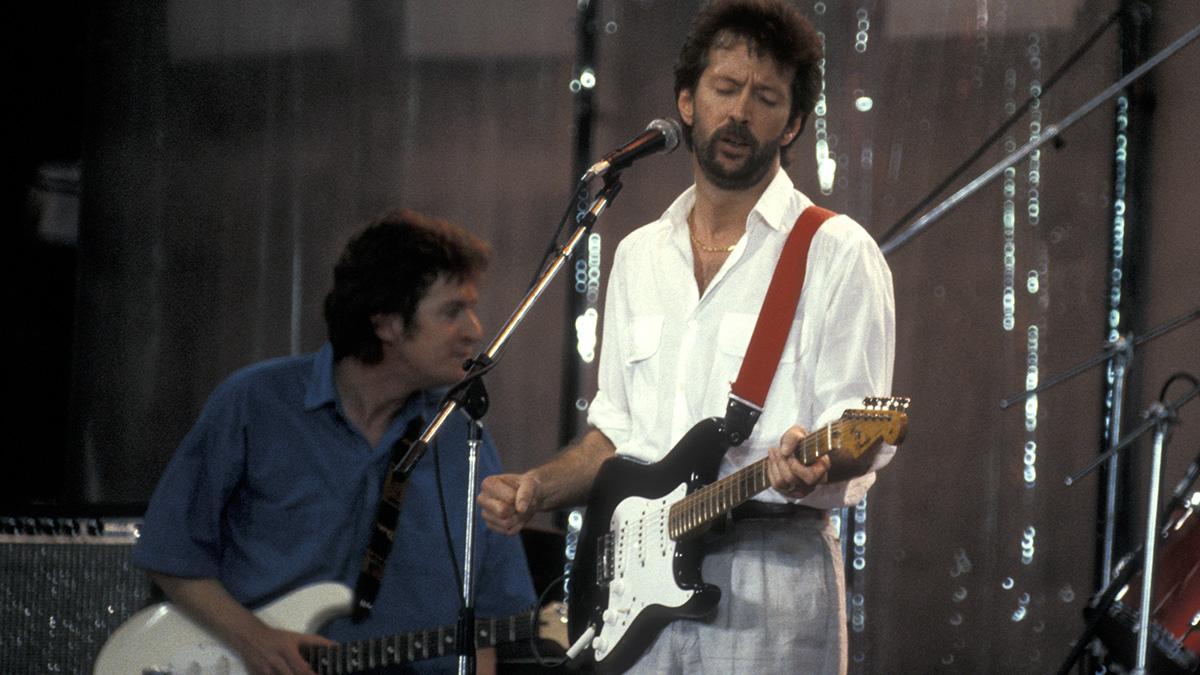“Cool with a capital C”: Eric Clapton’s Marshall JCM800 that rocked 1.5 billion people at Live Aid is up for sale
So you need an amp to play guitar in a stadium for a watching TV audience of over a billion people? Well, something has just come in... All you need is a cobbled together Strat

The ship just might have come in for all those tonehounds out there trying to nail Eric Clapton’s mid ‘80s electric guitar sound, because a Marshall JCM800 that was used by Slowhand during his legendary 1985 Live Aid performance is up for sale.
Clapton’s Live Aid set, which featured Phil Collins on drums, was one of the highlights of an event that would become the standout pop-cultural moment of the decade. It was watched by an estimated TV audience of 1.5 billion people, with Clapton’s performance of his Derek and the Dominoes standard Layla bringing the house down at JFK stadium in Philadelphia.
On the day, Clapton wore a white shirt, played his ‘Blackie’ Stratocaster, with a red guitar strap, and in in his backline that was this 1984 JCM800 Super Lead MKII, and this is the amp that is now being sold via London’s Denmark Street Guitars – send your enquires via email to justin@londonvintageguitars.com.
The guitar amp is being sold as a half-stack, with a matching 4x12 straight cabinet. Clapton had a number of JCM800s during this period, having moved back to Marshall after favouring Music Man amplifiers such as the HD 130 Reverb on account of them having a master volume.
Clapton used a couple of JCM800s that day, and while there are no further details on the listing – Denmark Street Guitars just posted it to its Instagram page – this looks it was part of the consignment of JCM800s that went under the hammer in 2011, when Bonham’s hosted a charity auction to raise money for the Crossroads Centre, Clapton’s addiction recovery centre in Antigua.
Marshall’s naming convention is a little arcane. Two of Clapton’s JCM800s were 1987 models, 50-watt tube heads. The other two were Super Lead MKII 1959s, which is the amp that is up for sale. It is a 100-watt tube head with the four-inputs configuration on the front.
A post shared by Denmark Street Guitars (@denmarkstguitar)
A photo posted by on
Clapton acquired these JCM800s in 1984 when he was working with Roger Waters, and they would feature on Waters’ debut solo album, The Pros and Cons of Hitch Hiking. They would be his main go-to amps until he switched to his dual Soldano SL 100 setup with the Pete Cornish switching system, though he reportedly still used one of the JCM800s to power his Leslie rotating speaker system.
Want all the hottest music and gear news, reviews, deals, features and more, direct to your inbox? Sign up here.
Marshall’s naming convention would confuse anyone but the simplicity of the control setup would have been just what Clapton was looking for. He favoured that in an amp – just turn it up and let it do its thing.
“I don’t like too many options in an amplifier,” Clapton told Guitar World. “The simplicity of an early Fender is what I want. If I want it to distort, I’ll just turn it up full volume, and it will do that. But when you’ve got all these permutations, you just spend too long fiddling around on the knobs.”
Jonathan Horsley has been writing about guitars and guitar culture since 2005, playing them since 1990, and regularly contributes to MusicRadar, Total Guitar and Guitar World. He uses Jazz III nylon picks, 10s during the week, 9s at the weekend, and shamefully still struggles with rhythm figure one of Van Halen’s Panama.

